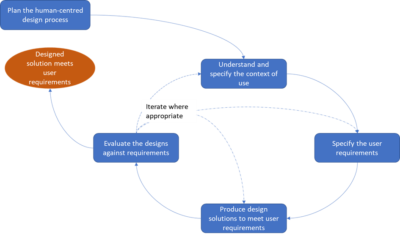https://www.iso.org/standard/31176.html
Human centred design
About this topic
Introduction
Human-centred design (HCD) is an approach to design that aims to make products and systems usable and useful by focusing on users and their goals, characteristics, needs and requirements. By applying human factors knowledge and methods and with an emphasis on usability, this approach enhances efficiency, well-being, accessibility and user satisfaction, and reduces the potential adverse effects of use on the health, safety and performance of those interacting with or utilizing a system. A HCD approach allows designers to understand how a system will behave when in operation because context of use has been considered and the design is based on user requirements identified right at the beginning of the design lifecycle.
Key principles of human-centred design are as follows:
- The design is based on an explicit understanding of users, tasks and environments;
- Users are involved throughout design and development;
- The design is driven and refined by user-centred evaluation;
- The process is iterative;
- The design addresses the whole user experience; and
- The design team includes multidisciplinary skills and perspectives.
Relevance to Rail
Many rail projects will involve new or altered systems with a user interface – whether it be systems providing passenger information, for signalling and train control, to support inspection and maintenance activities through asset monitoring, or the design of the trains themselves. HCD is fundamental in facilitating the integration of human factors into design. As well as helping to ensure design is fit for purpose based on the context of use and the intended user, it can help facilitate user acceptance of and engagement with change. In providing a structured approach, it supports a defensible design safety case and helps reduce the adverse impacts that can result from user-led design, or design that does not consider the end user at all – adverse impacts that can range from increased cost associated with design rework, to critical incidents resulting from operator error, mistake or violation. The approach ensures that systems are designed so that our end users – signallers, drivers, station staff, maintainers and passengers – are supported by the system.
Approaches and Models
The figure below provides an overview of a human-centred design approach, and how each of the elements relate to one another over the design lifecycle.

Figure 1: Interdependence of human-centred design activities (ISO 9241 – 210).
ISO/TS 18152:2010 Ergonomics of human-system interaction — Specification for the process assessment of human-system issues
https://www.iso.org/standard/56174.html
ISO 9241 – 220:2019 Ergonomics of human-system interaction: Processes for enabling, executing and assessing human-centred design within organizations
https://www.iso.org/standard/63462.html
ISO 9241 – 210:2019 Ergonomics of human-system interaction: Human-centred design for interactive systems
https://www.iso.org/standard/77520.html
ISO/TR 16982:2002 Ergonomics of human-system interaction — Usability methods supporting human-centred design.
https://www.iso.org/standard/31176.html
ISO/TS 18152:2010 Ergonomics of human-system interaction — Specification for the process assessment of human-system issues
https://www.iso.org/standard/56174.html
ISO 9241 – 220:2019 Ergonomics of human-system interaction: Processes for enabling, executing and assessing human-centred design within organizations
https://www.iso.org/standard/63462.html
ISO 9241 – 210:2019 Ergonomics of human-system interaction: Human-centred design for interactive systems
https://www.iso.org/standard/77520.html
ISO/TR 16982:2002 Ergonomics of human-system interaction — Usability methods supporting human-centred design.
https://www.iso.org/standard/31176.html
ISO/TS 18152:2010 Ergonomics of human-system interaction — Specification for the process assessment of human-system issues
https://www.iso.org/standard/56174.html
ISO 9241 – 220:2019 Ergonomics of human-system interaction: Processes for enabling, executing and assessing human-centred design within organizations
https://www.iso.org/standard/63462.html
ISO 9241 – 210:2019 Ergonomics of human-system interaction: Human-centred design for interactive systems
https://www.iso.org/standard/77520.html
Join us
Are you interested in HOF?
Do you want to learn about Human & Organisational Factors? Safety culture, non-technical skills, health and safety, more?
Join us on this international and diverse network which captures in one place the valuable and enriching information and material, either academic or practical railways-oriented, on the organizational and human factors that you need.
Are you involved in HOF activities?
You want to learn about Human & Organisational Factors? Safety culture, non-technical skills, health and safety, more?
Join us on this international and transversal network which capitalizes the valuable and enriching information and material, either academic nor Railways oriented, on the organizational and human factors that you need.
Are you an HOF expert?
Are you a Rail Human and Organisational factors expert, a Rail Safety expert, a Railway Head of safety, or other? This space is made for you. Here, you have access to confidential information and can even create or participate in a discussion forum to initiate conversations and exchanges with your peers.
